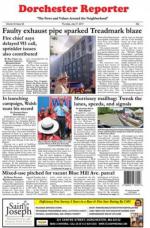June 26, 2020

Education Commissioner Jeff Riley said additional funding combined with the eventual fate of the Chapter 70 increases will "allow us to go back to in-person schooling in a robust format." [Photo: Pat Greenhouse/Boston Globe/Pool]
Allowing hundreds of thousands of K-12 students to resume learning in school buildings this fall will improve educational outcomes, relieve pressure on families and boost supports for the state's most vulnerable children, Baker administration officials said as they unveiled a back-to-school framework Thursday.
The new guidance from state leaders instructs districts to prepare for in-person education to resume after the summer with a range of new COVID-19 safety protocols, from space requirements between desks to mandatory face coverings for most students, that will alter the school environment in ways not previously contemplated.
To be ready for different scenarios, districts were also instructed to plan hybrid and fully remote models, and while the trajectory of the outbreak remains unclear amid spikes in some of the nation's largest states, Gov. Charlie Baker and his deputies stressed the importance of bringing students back into classrooms.
"In developing the back-to-school plans, the department and our administration considered not only the risks associated with COVID-19 for in-person schooling, but also the risks associated with continuing to keep students out of the classroom," Baker said at a press conference. "Continued isolation poses very real risks to our kids' mental and physical health, and to their educational development."
The new framework the Department of Elementary and Secondary Education outlined Thursday explicitly targets bringing back "as many students as possible" to in-person settings for the fall as a statewide goal.
On March 17, school buildings abruptly closed as the outbreak hit Massachusetts in full force, and students spent the rest of the academic year learning virtually -- a model that highlighted wide gaps in access to technology and added strain to parents, as well as some students and educators.
As districts now move toward returning, they must prepare to educate the more than 950,000 public school students in Massachusetts differently than before the pandemic.
Districts should rearrange classrooms to maintain a minimum of three feet between desks and six feet whenever possible, DESE said. To do that, class sizes will need to shrink, and the administration encouraged districts to use libraries, auditoriums and cafeterias for additional space and to enlist specialist teachers, instructional coaches, reading specialists and any others who are properly certified to serve as "additional core teachers."
All students in the second grade and older and all adults will be required to wear face coverings or shields, while kindergarteners and first-graders will be encouraged to do so. Students with medical conditions or other safety issues will not need to comply, and schools must plan for mask breaks during the day.
Schools will also need to divide students into smaller cohorts that, to the greatest extent possible, do not interact with one another. In a hybrid model, separate groups would attend school in-person on different days or weeks to avoid overlap.
State officials did not set a hard cap on group or classroom sizes, leaving it up to local education officials so long as they comply with distancing requirements.
"These rules take every precaution possible, and are grounded in the best possible medical advice," said Lt. Gov. Karyn Polito.
If public health indicators regress and Massachusetts sees a significant uptick in cases, the administration may instruct schools -- either before the fall or partway through the school year -- to switch from full in-person instruction to either the partial or full remote learning models they must develop.
The administration crafted the guidelines with input from medical experts, and both Massachusetts General Hospital infectious disease specialist Dr. Sandra Nelson and American Academy of Pediatrics Massachusetts Chapter President Dr. Lloyd Fisher joined Baker's team to promote the plan Thursday.
Based on available research into the novel coronavirus, children appear less likely to contract or transmit COVID than adults and less likely to become severely ill if they do catch the disease. That understanding indicates that schools will have a lower risk of infection than many other public settings, experts said.
"While for most children, COVID-19 has not had the devastating and life-threatening physical health effects that have occurred in adults, the negative impact on their education, mental health and social development has been substantial," Fisher said during the press conference. "The school experience provides so much more than academic learning, and the relationships that children form with their teachers, other school personnel and their peers are critical to their emotional health and well being."
Districts will not be required to implement temperature checks or other mandatory screening for COVID symptoms, largely because officials believe children will display high rates of false positive or false negative tests.
Much of the responsibility for detecting potential infections will rest with parents, whom districts will ask to check their children for symptoms and keep them home from school if they are sick or have had contact with someone who is.
Schools must plan to make remote learning available to any students whose families feel they cannot safely return in the fall, and the administration also instructed district leaders to develop focused plans for students with special needs.
One option officials recommended would be to ensure that students with special needs participate in-person every day, regardless of whether a school has a plan in place to rotate other students' presence in the building.
Baker said he and Lt. Gov. Karyn Polito received the most feedback over remote learning during the spring from parents of such students, who warned that their children "regressed dramatically" while away from the school environment.
"I can't emphasize how important, especially for those kids and their families, that face time and that daily routine and that constant sense of communication and progress is to their ability to continue to grow and develop," Baker said.
Preparing the three models and implementing the new protocols will be a costly endeavor for many districts, particularly those in low-income communities that already face budget shortfalls.
While the planned implementation of a new school funding law remains up in the air amid the current recession, districts in Massachusetts will be able to access nearly $1 billion in state and federal aid to help them during the transition, Baker said.
The administration plans to make $202 million available from its share of the federal Coronavirus Relief Fund to support reopening, and it will launch a separate $25 million matching grant program for virtual education technology. Those will supplement earlier federal grants directed to cities and towns for education needs.
That money will be critical for communities that must now anticipate annual local aid remaining level, at least for the start of the fiscal year, despite Baker's pre-pandemic budget planning to inject $303.5 million more into the Chapter 70 education funding program.
"We know this work will require resources and that districts will have to plan for those resources," said Elementary and Secondary Education Commissioner Jeff Riley. "We know that, in particular, special attention needs to be paid to our historically underfunded school districts."
Layoffs in K-12 districts have spiked this year, Riley said, amid uncertainty over budget outlooks. He said the additional funding combined with the eventual fate of the Chapter 70 increases will "allow us to go back to in-person schooling in a robust format."
Several key questions remain unanswered in the guidelines released Thursday. While DESE informed districts that all students should cover their faces on school buses, it will not provide more instruction on school transportation until July. The department also plans to issue guidance next month about fall sports.
A Suffolk University poll conducted last week found that 49 percent of parents with school-aged children are not yet comfortable sending them back to school or day care, compared to 45 percent who are comfortable and 16 percent who are undecided.
Teacher unions flagged concerns with the approach in the wake of Thursday's announcement.
The American Federation of Teachers' Massachusetts chapter said DESE's plan "needs improvement in several key areas," criticizing it for expecting most families to provide students with their own face coverings, lacking transportation information and only recommending a three-foot distance.
"This guidance may work for a few of the wealthiest suburban districts, where families can afford to purchase their own protective equipment, where students are generally driven to school, and where local taxpayers can provide the additional funding required to open safely," said AFT Massachusetts President Beth Kontos. "But DESE’s guidance discounts the needs of high-poverty districts in our Gateway Cities and Boston, which have been disproportionately affected by COVID-19 and were already deeply underfunded before this crisis began."
Both AFT and the Massachusetts Teachers Association called for Beacon Hill to fully fund the first year of the Student Opportunity Act, describing that additional money as critical to ensuring safe instruction this fall.
"Significant funding will be required for personal protective equipment, adequate staffing to enable physical distancing, and additional supports to address students' social, emotional and academic needs," MTA President Merrie Najimy said in a statement. "This is important across the state -- and it is particularly crucial for low-income students and students of color who live with the consequences of the structural racism of underfunded schools."
Senate President Karen Spilka, a former Ashland School Committee member, called it a "good idea" to have three different models, and said she expected the Education Committee will take a close look at the department's guidance. "We need to ensure that our schools are prepared for different scenarios," she told the News Service.
The Massachusetts Business Alliance for Education predicted the pandemic will cause "full or partial closures of schools and irregular schedules, an extended reliance on full or hybrid remote learning models, and an unfair choice being placed on many families to have to choose between risking their students' health or their ability to learn due to subpar remote learning strategies or lack of digital access."
The alliance emphasized four goals: closing digital equity gaps, making safety the priority and assessing and addressing learning loss, ensuring timely, clear and prescriptive state guidance, and prioritizing funding with a focus on the highest need students and districts.



